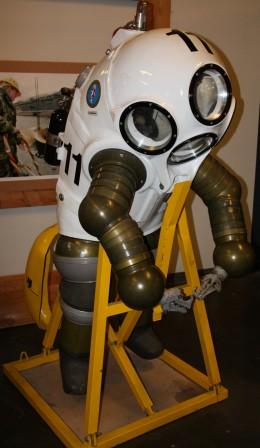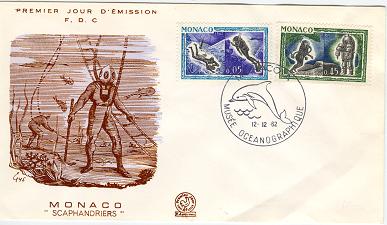|
The better known Jim Suit, ADS- Atmospheric Diving Suit
 Two British engineers sat in a smoky Brighton pub, deep in conversation with an old man. It was 1965, the North Sea was being explored for oil, and the industry was looking out for ways to get divers onto the deep ocean floor. The race was on to develop a working Atmospheric Diving Suit, and 80 year old "Pop" Peress was the only person with a possible solution to the problems involved. Two British engineers sat in a smoky Brighton pub, deep in conversation with an old man. It was 1965, the North Sea was being explored for oil, and the industry was looking out for ways to get divers onto the deep ocean floor. The race was on to develop a working Atmospheric Diving Suit, and 80 year old "Pop" Peress was the only person with a possible solution to the problems involved.
The engineers, Mike Borrow and Mike Humphrey, were already making a range of technical diving equipment under the name of UMEL (Underwater Marine Engineering Ltd). Pop Peress had spent two decades trying to develop an ADS, but had lost heart when the fruits of his labor sparked little commercial interest. That was 30 years earlier.
The engineers wanted to be the first to develop an updated ADS, and had a proposition for Peress.
The story of the Jim suit, as it was to become known, begins in England in 1914, when 18-year-old Joseph Salim Peress was offered a job by the aircraft manufacturer de Havilland as a trainee draftsman.
The young Peress grew up in the Middle East, where he had watched Persian Gulf pearl divers in action and seen how they suffered from the bends. He had a natural flair for engineering design, and had challenged himself to construct an articulated diving suit that would keep divers dry and at atmospheric pressure, even at great depth.
At the time, little was known about decompression diving. Various atmospheric suits had been developed during the Victorian era, but nobody had managed to overcome a basic design problem - the construction of a joint that would remain flexible and watertight at depth. The joints that had been made seized up under pressure.
In 1918 Peress began working for WG Tarrant at Byfleet, Surrey, where he was given the space and tools to develop his ideas. His first attempt at an ADS was an immensely complex construction machined from solid stainless steel.
In 1923 the P&O liner Egypt sank in 122m of water after a collision off the French island of Ushant. It held a cargo of 10 million in gold bullion, and Peress was asked to design a suit for the salvage operation. He declined, insisting that his prototype steel suit was still too heavy for a diver to handle.
Peress was nonetheless encouraged by the request, so set to work on another suit using lighter materials. By 1929, he thought he had cracked the weight problem, and in the process had managed to improve the flexibility of the joints.
Peress was next recruited by a Greek industrialist looking for a "deep-diving armour". This time Peress`s designs were already drawn, and he accepted the commission.
The resulting Tritonia suit showed a great deal of innovation. Peress used magnesium in the main body, which had a better strength-to-weight ratio than steel, and he redesigned the joints with a piston moving in an annular semi-hemispherical cylinder. As the joint moved, it pushed the piston, which was sealed with leather washers, along a curved cylinder filled with oil (see diagram).
By 1930 Peress had completed the trials and the Tritonia was demonstrated publicly in a small tank at Byfleet in May. In September it was taken to Loch Ness on board the Recovery where Peress`s assistant, Jim Jarret, dived the suit to 135m. It performed perfectly - the joints proved insensitive to pressure and moved freely, even at depth.
However, Peress`s Greek sponsor chose not to use the suit, so he offered it to the Royal Navy. It too turned the suit down, insisting that Navy divers never needed to dive beyond 90m.
Jim Jarret made one more deep dive to 90m on the Lusitania off the south coast of Ireland, followed by a shallower dive to 60m in the Channel in 1937. Then, due to lack of interest, the Tritonia was retired.
Peress gave up and turned his attention elsewhere. He became a millionaire by pioneering plastic moulding, and formed a company that became the world`s largest manufacturer of turbine blades for the aircraft industry.
With a bit of persuasion from Mike Borrow and Mike Humphrey, Pop Peress agreed to come out of retirement. The team set to tracking down the original Tritonia suit. It was found lying in pristine condition in a Glasgow workshop, where it had been hidden for 30 years under a pile of rubbish.
The suit was dusted off and dived for the first time by 80-year-old Peress in the factory test tank. It worked perfectly.
Mike Borrow remembers: "Getting Pop into the suit was not too difficult but it took about three hours to get him out. We had to lay the suit down and unbolt the limbs one by one. Then, because he could not point his toes, he got jammed in. Luckily he was a bit of a character and could see the funny side of it!"
Five years later the team unveiled two modern atmospheric suits using the Peress joint. The test depth for the new model was to be a staggering 610m, and it was to be named "Jim" after the first ADS diver, Jim Jarret.
The suit was completed in 1971 and sea trials took place in 1972 on the Royal Navy salvage vessel HMS Reclaim to a depth of 152m. It worked perfectly and weighed only 27kg in the water. These trials were followed by record-breaking dives by Mike Humphrey to 305m in a massive test vessel at Portland.
By the 1980s Jims were being used around the world to depths beyond 600m. UMEL went on to develop special Jims for the US Navy with body-shells constructed of carbon fibre reinforced plastic. Eventually the patents were bought by Oceaneering in the USA.
Pop Peress died in 1978, after seeing his dream for a working ADS finally reach a successful conclusion.
Back to History Index
 |
Monaco |
1962 |
Deep divers,Jim suit and Karl H. Klingert 1797, 12 Dec' 1962 |
 |
Monaco |
1962 |
Deep divers,Jim suit and Karl H. Klingert 1797 |
|